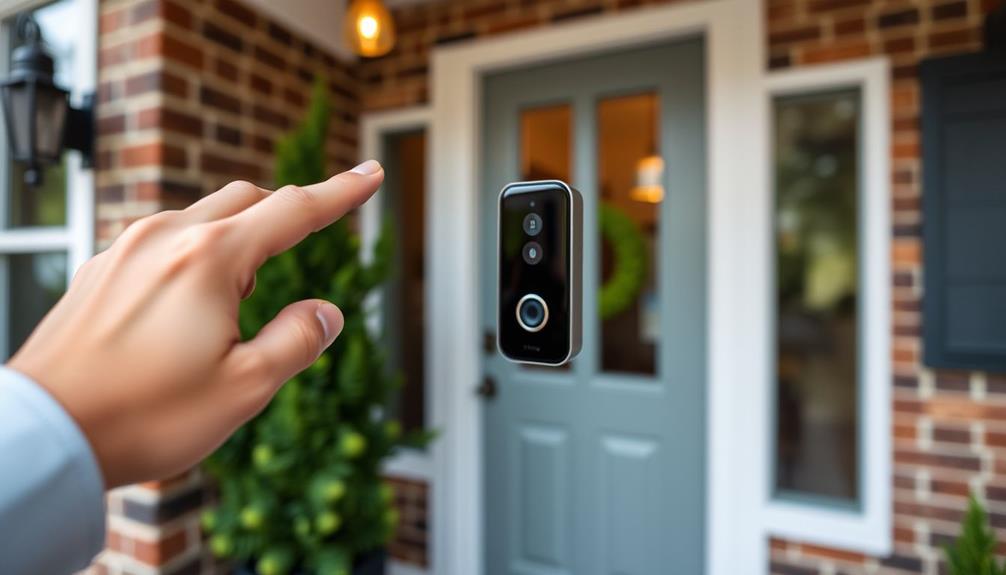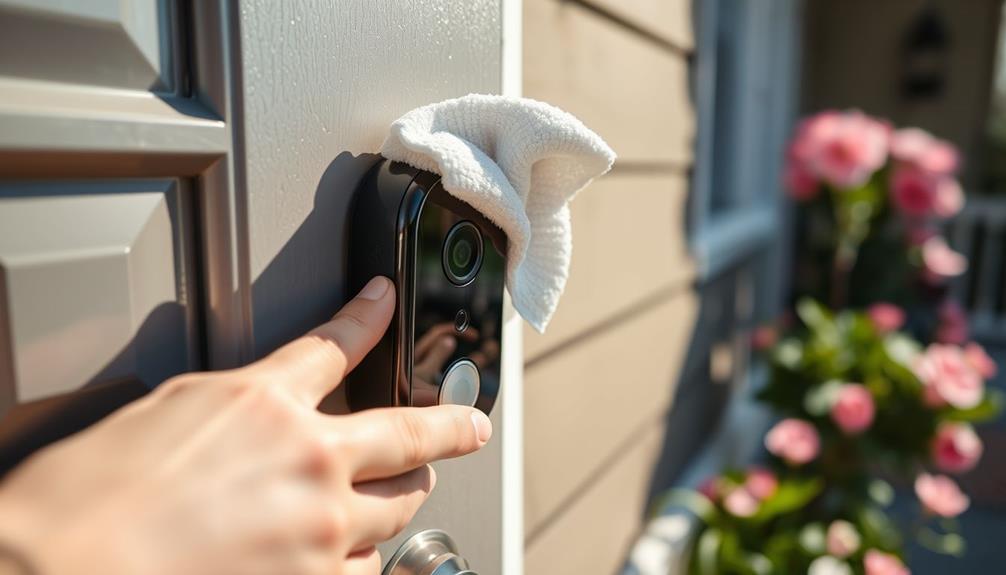For optimal performance of your Ring Doorbell, it is recommended to set your router to channel 1, 6, or 11 on the 2.4 GHz band. These specific channels are known to reduce interference and ensure a stable connection, which is crucial for maintaining high video quality. Although Channel 6 is particularly effective, all three options are non-overlapping and help prevent signal disruptions. Keep in mind that a strong signal is key for dependable operation, so also take into consideration the distance between your doorbell and the router. By adjusting these settings accordingly, you can improve your overall experience with the Ring Doorbell, and further guidance on achieving the best setup is available for you to explore.
Key Takeaways
- Set your router's 2.4 GHz channel to 6 for optimal performance and minimal interference with the Ring Doorbell.
- Use channels 1 or 11 as alternative options for the 2.4 GHz band to avoid overlapping signals.
- Regularly check your RSSI value; aim for above -60 dBm for reliable connectivity with the Ring Doorbell.
- Create a separate SSID for the 2.4 GHz network to prevent accidental connections to the 5 GHz band.
Understanding Ring Doorbell Requirements
To guarantee your Ring doorbell functions properly, you need to understand its specific Wi-Fi connection requirements. The Ring doorbell primarily connects to 2.4 GHz Wi-Fi networks, which means you should configure your router accordingly.
To optimize performance, focus on using recommended channels like 1, 6, or 11. These channels minimize interference and help enhance signal strength, which is vital for reliable connectivity. Additionally, making sure a clean indoor environment can contribute to better device performance, as air quality can impact electronics.
Assess the quality of your Wi-Fi signal by checking the RSSI (Received Signal Strength Indicator) value. If it's below -70 dBm, you're likely experiencing poor connectivity, which can affect your Ring doorbell's performance.
To improve your signal, avoid congested channels where other devices might compete for bandwidth. It's also a good idea to set your router to a fixed channel instead of letting it switch automatically.
If you have hidden networks, be aware that you'll need to enter these manually during the setup process, as the Ring doorbell won't detect them automatically.
Importance of 2.4 GHz Band

Understanding the specific requirements of your Ring doorbell highlights the importance of utilizing the 2.4 GHz band for a reliable connection. This band is ideal for devices located further from the router, providing a longer range than the 5 GHz alternative.
In the context of energy efficiency, utilizing devices like a Ring doorbell can contribute to eco-friendly and reliable energy sources.
To guarantee peak performance, set your 2.4 GHz Wi-Fi to channel 6. This channel minimizes interference and helps maintain a strong signal, reducing connectivity issues commonly reported by users.
In the domain of 2.4 GHz, channels 1, 6, and 11 are the only non-overlapping channels available, making them your best options for reducing congestion.
A strong 2.4 GHz signal is essential for your Ring doorbell, as poor RSSI values can lead to intermittent video quality and delayed notifications.
By focusing on the 2.4 GHz band and selecting the right channel, you create a more stable environment for your Ring device, making certain it functions as intended.
Recommended Router Channels

Choose the right router channel to guarantee your Ring doorbell operates smoothly and efficiently. For ideal performance, you'll want to set your 2.4 GHz router channel to either 1, 6, or 11, as these channels are the most recommended for minimizing interference. Channel 6 is particularly favored since it avoids overlap with adjacent channels.
If your router supports 5 GHz, consider using channels 36, 40, 44, or 48. Avoid channels above 48 to prevent connectivity issues. Remember, manual selection of Wi-Fi channels is essential; automatic channel hopping can lead to instability and disconnections for your Ring devices.
Regularly monitoring and adjusting your router's channel settings can greatly enhance connectivity and performance, especially in crowded Wi-Fi environments. Here's a quick overview of the recommended channels:
| Frequency Band | Recommended Channels |
|---|---|
| 2.4 GHz | 1, 6, 11 |
| 5 GHz | 36, 40, 44, 48 |
| Manual Selection | Essential for stability |
| Interference | Minimize for better performance |
| Ring Devices | Optimize for reliable connectivity |
Configuring Your Router

Configuring your router properly guarantees that your Ring doorbell maintains a strong and reliable connection. Start by setting your 2.4 GHz Wi-Fi to Channel 6. This channel is recommended for minimizing interference, assuring peak performance. It's important to take into account cybersecurity measures, especially when configuring smart devices like your Ring doorbell, as continuous learning in tech fields helps understand the importance of secure connections. Avoid using channels above 11 for your 2.4 GHz network, as they can lead to connectivity issues for your Ring device.
Next, focus on your 5 GHz band. Channels 36, 40, 44, or 48 are ideal for enhancing signal strength and reducing congestion. To streamline connections, create separate SSIDs for your 2.4 GHz and 5 GHz networks. This prevents your Ring doorbell from inadvertently connecting to the less compatible 5 GHz band.
It's also wise to regularly check your router settings. If you notice any connectivity issues, manually adjust the Wi-Fi channel, since automatic channel switching mightn't always maximize performance for your Ring doorbell.
Troubleshooting Connectivity Issues

When it comes to troubleshooting connectivity issues with your Ring doorbell, selecting the right router channel is essential.
You'll want to focus on improving signal strength to guarantee a stable connection.
Investing in quality headphone extension cables can also help reduce interference, which might benefit your overall home network performance.
Let's explore how ideal channel selection and signal strength can enhance your Ring doorbell's performance.
Optimal Channel Selection
Selecting the right Wi-Fi channel is vital for ensuring your Ring doorbell maintains a strong and reliable connection. With advancements in AI-driven solutions emphasizing the importance of technology in connectivity, it's important to choose wisely.
For ideal performance, consider the following:
- Use Channel 6: This is the best choice for the 2.4 GHz network, as it minimizes interference and enhances connectivity.
- Stick to Non-Overlapping Channels: Channels 1, 6, and 11 are your best bets. These non-overlapping channels help maintain stable connections.
- Dual-Band Router Benefits: If you have a dual-band router, create separate SSIDs for your 2.4 GHz and 5 GHz bands. This way, your Ring doorbell connects to the correct band without interference.
Signal Strength Improvement
Improving your Ring doorbell's signal strength starts with checking its current RSSI value in the app to identify potential connectivity issues. Aim for a value above -60 dBm for dependable performance. If your signal's weaker, consider adjusting your router channel or location.
Here's a quick guide to help you troubleshoot:
| Action | Details |
|---|---|
| Check RSSI Value | Look for a value above -60 dBm for ideal signal. |
| Change Router Channel | Use a Wi-Fi analyzer to select a less crowded channel. |
| Reboot Router | Monthly rebooting can enhance signal strength. |
| Remove Physical Obstructions | Relocate your router or remove items blocking the signal. |
For the best results, use the 2.4 GHz band, setting the router channel to 1, 6, or 11. This reduces interference and helps maintain a strong connection. If you're still facing connectivity issues, try relocating the router closer to your Ring Doorbell. By taking these steps, you can guarantee your device has an ideal signal and improved performance.
Enhancing Performance and Reliability

To enhance the performance and reliability of your Ring Doorbell, connect it to a 2.4 GHz network set to channel 6, which minimizes interference and maximizes signal strength. This setup not only improves connectivity but also reduces congestion from nearby networks, similar to how best practices in software quality assurance can optimize performance.
Here are three essential tips for optimizing your Wi-Fi network:
- Choose the Right Channel: Stick to channels 1, 6, or 11 on your 2.4 GHz network, as these don't overlap and help maintain clear signals.
- Monitor Network Traffic: Regularly check for congestion in your area. Adjusting your channel based on network traffic can considerably boost your Ring Doorbell's reliability.
- Use a Dedicated SSID: Create a specific 2.4 GHz SSID for your Ring Doorbell. This will prevent it from connecting to a 5 GHz network, which it doesn't support, ensuring a stable link.
Frequently Asked Questions
What Are the Best Router Settings for Ring Doorbell?
To optimize your router settings, use channels 1, 6, or 11 for 2.4 GHz. Disable WMM and MU-MIMO, and monitor RSSI values in the Ring app to guarantee a strong connection.
Should the Ring Doorbell Be on 2.4 or 5?
You should connect the Ring Doorbell to a 2.4 GHz network. It only supports this frequency, ensuring better range and connectivity, while 5 GHz networks won't work at all for your doorbell's functionality.
What Is a Good Wifi Signal for Ring Doorbell?
Imagine your Ring Doorbell struggling to connect, notifications delayed. A good Wi-Fi signal shows an RSSI of -50 dBm or better. Keep it close to your router to guarantee smooth operation and clear video quality.
What Is the Best Channel for a Wifi Router?
To find the best channel for your Wi-Fi router, consider using channels 1, 6, or 11 on the 2.4 GHz band. They minimize interference, improving your connection stability and overall performance considerably.
What is the Best Router Channel to Use for the Ring Doorbell?
When setting up your Ring doorbell, it’s important to find the best router settings for ring to ensure a strong and reliable connection. It’s recommended to use channel 1, 6, or 11 for the 2.4GHz band, as they are the least crowded and can provide the best performance for your Ring doorbell.
Conclusion
In the world of smart devices, a strong connection is key—after all, you can't build a house on sand.
By choosing the best router channel for your Ring Doorbell, you guarantee it stays connected and responsive.
Remember to use the 2.4 GHz band and adjust settings as needed to enhance performance.
With a little effort in configuring and troubleshooting, you'll enjoy reliable security at your doorstep, giving you peace of mind wherever you are.









